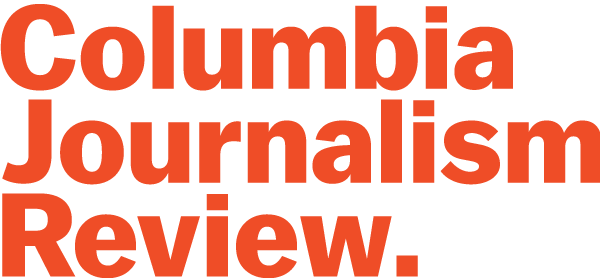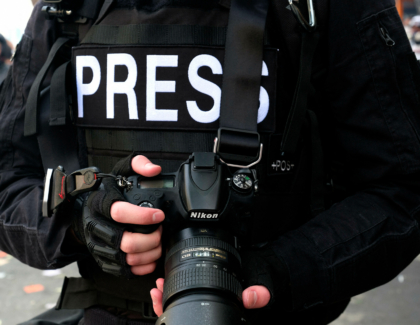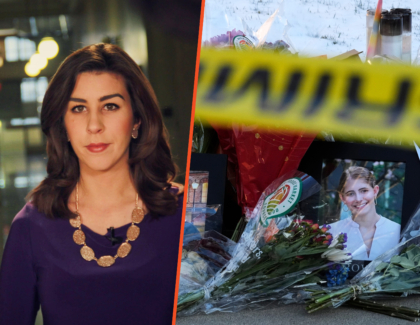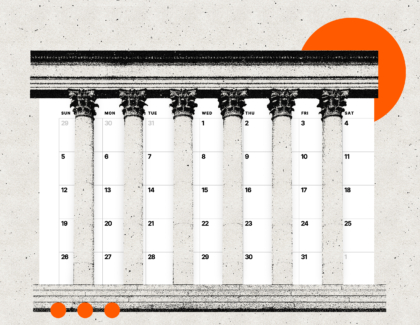Sign up for the daily CJR newsletter.
An Australian TV journalist was covering a protest on US soil when law enforcement violently assaulted her. It was caught live on camera for the world to see. The prime minister of Australia expressed concern. The journalist said that she was “a bit sore,” but doing okay. The incident unfolded against the backdrop of what was widely decried as a Trumpian stunt.
All this happened in June 2020, when officers with the Park Police in Washington, DC, charged at Amelia Brace, a reporter with the Australian network 7News, and her cameraman Tim Myers as they cleared protesters from an area outside the White House so that Trump could walk to a nearby church to do a photo op with a Bible, accompanied by Mark Milley, the chairman of the Joint Chiefs of Staff. (Milley soon apologized, acknowledging that his involvement had “created a perception of the military involved in domestic politics”; Brace and Myers were also struck with rubber bullets.) And all this happened again in June 2025. On Sunday, Lauren Tomasi, a reporter with 9News, was talking to camera in Los Angeles when a law enforcement officer behind her visibly turned toward her and shot her in the leg with a rubber bullet, causing Tomasi to cry out in pain. (“You just fucking shot the reporter!” someone could be heard shouting.) Anthony Albanese, the Australian prime minister, called the footage “horrific” and said that he had expressed his concern to the Trump administration. (“We don’t find it acceptable that it occurred,” he said. “We think that the role of the media is particularly important.”)
This echo of 2020 may have been particularly uncanny, but it wasn’t the only one to emerge from LA over the weekend, as journalists covered a series of immigration raids in the city, the popular protests that followed, and the increasingly intense law enforcement response that followed that. In 2020, police in Minneapolis—where a white police officer had just murdered George Floyd, triggering mass demonstrations in that city and then nationwide—shot Linda Tirado, a photojournalist, in the eye with a foam-tipped plastic bullet, necessitating emergency surgery; this past weekend, a plastic bullet tore into the thigh of Nick Stern, a photojournalist, in LA, necessitating emergency surgery. (Indeed, Stern himself was also hit by police projectiles back in 2020.) Back then, Omar Jimenez was reporting live for CNN from Minneapolis when he was arrested, cuffed, and led away. Last night, Jason Carroll was reporting live for CNN from LA when he wasn’t arrested, but was briefly detained and told to put his hands behind his back, before being escorted out of a protest zone.
As protests continued through the summer of 2020, dozens of journalists were assaulted and well over a hundred were arrested or detained, according to data compiled by the US Press Freedom Tracker. This time around, we’re not quite there yet; as Katherine Jacobsen, of the Committee to Protect Journalists, told the Washington Post, “It’s important not to extrapolate that this might turn into something like what we saw in 2020 and to kind of get ahead of ourselves.” Jacobsen added, however, that “at the same time it’s very, very difficult not to reflect on the patterns we’re seeing, as far as the use of force in these types of situations, and the way that it adversely affects journalists’ ability to safely do their jobs.” Yesterday, CPJ reported that there have been more than twenty “incidents of obstruction and attacks against members of the media” in LA since Friday; Reporters Without Borders (RSF) counted even more. Kirstin McCudden, the managing editor of the US Press Freedom Tracker, told me yesterday that her team was working to report on at least twenty-six incidents, including seventeen separate assaults of fourteen different journalists, two instances of equipment damage, two searches of journalists’ bags, and “copious amounts of tear gas.” (CPJ, RSF, and McCudden all cited the helpful work of the Los Angeles Press Club in keeping a running tally of the incidents.) In 2020, Sergio Olmos, an independent journalist covering unrest in Portland, Oregon, remarked that it was “as dangerous as it’s ever been out there,” as I noted in this newsletter at the time. Yesterday, Olmos, now with CalMatters, told the Post that he’d never seen police fire as many “less lethal” projectiles in one day as they did in LA on Sunday.
Trump’s Bible photo op in 2020 was one episode in a much broader, and more complicated, story, but at the time, it felt like a new low for him, as I wrote in this newsletter; the incident inspired media talk of fascism, an insistence that it not simply be erased by his next outrage (and this from a prominent Republican), and even predictions that Trump might simply refuse to leave office should he lose that year’s election. (Look how those turned out.) In that newsletter, I referenced another viral image from the time, depicting members of the DC National Guard, all clad in tactical gear, amassed on the steps of the Lincoln Memorial.
The question of National Guard involvement has dominated coverage of the LA protests, too: over the weekend, Trump’s new administration mobilized two thousand members of the California National Guard; yesterday, it mobilized two thousand more, plus seven hundred Marines for good measure. This time around, the whole story looks like one great big media stunt. As CNN’s Brian Stelter noted yesterday, Dr. Phil was given special access (again) to the initial immigration raids in LA last week. Trump’s mobilization of the National Guard was the first time since 1965 that a president has taken such a step over the head of a state’s governor, in this case the Democrat Gavin Newsom, who has made it clear that the move was not only unnecessary, but deliberately inflammatory, and is now suing. Newsom himself, of course, is no stranger to the media spotlight; on Sunday, he invited NBC’s Jacob Soboroff into an emergency operations center, blamed Trump for creating “the conditions that you see on your TV tonight,” and challenged Tom Homan, Trump’s so-called border czar, to arrest him, after Homan seemed to threaten to do so. (“He’s a tough guy; why doesn’t he do that?” Newsom said. “Tom, arrest me. Let’s go.”) Yesterday morning, Homan responded by playing down that prospect and attacking Soboroff as a “joke.” Then, however, Trump told reporters that he would arrest Newsom, if he were Homan. All of this, predictably, drove headlines. And that, broadly, seems to be what the White House wants. (This morning, Politico quoted a “gleeful person close to the White House” as saying, “We couldn’t script this any better.”)
Putting the pissing match to one side, Trump’s behavior here marks an escalation compared with 2020. Back then, he told ABC’s George Stephanopoulos that “we can’t call in the National Guard unless we’re requested by a governor,” and suggested that he would never invoke the Insurrection Act to give him greater latitude to deploy troops domestically. He hasn’t yet done the latter this time—but he seems explicitly to be leaving the door open to it. And his response has already been glaringly disproportionate. There has been some vandalism and violence in LA, but the protests have mostly been peaceful, especially before Trump decided to call in the National Guard. And they’ve been pretty limited in scope; the apocalyptic images of, for example, burning cars that have been splashed across the media reflect reality, but don’t represent the broader picture in LA, however many administration officials might take to Fox News to slam the city as a Third World–esque hellhole full of criminals. Over the weekend, CNN’s Stelter noted that he’d received messages from friends on the ground telling him: “I’m sure you know this, but 99.9 percent of LA is going about their Sunday normally.” David Dayen, the executive editor of the American Prospect, who has lived in the city for over twenty years, wrote yesterday that protests “abbreviated in the media as ‘unrest’…were actually a cry of hope.”
Comparing this story to 2020 is a fraught exercise, and should be undertaken with care—that was a complicated summer, and its narrative and lessons have been subjected to a great deal of revisionist history ever since then, on the Trumpist right, but also among anti-woke media types and others. But certain echoes are, again, unmistakable. One throughline that’s also worth noting is the centrality of routine American law enforcement agencies to both stories, in ways that go beyond Trump. In 2020, of course, it was a police murder that precipitated months of protests, and local police and law enforcement officers were often to blame for the subsequent attacks on reporters and others. The tail of the latter story has been long. While most media workers who were arrested during those protests saw their charges dismissed, some were dragged through a longer legal nightmare, as I wrote in 2021. It took until 2023 for the Interior Department’s inspector general to conclude that Park Police officers used excessive force against Brace and Myers, the Australian journalists outside the White House. Police-violence cases brought by journalists and others have continued; just yesterday, the city of Denver reportedly agreed to settle one such suit brought by a group of journalists, YouTubers, and activists. Last year, it was reported that Tirado, the photojournalist shot in the eye in Minneapolis, is dying as a result of her injuries.
For all the understandable focus on the National Guard and the Marines, their actual role on the ground is murky. And officers of the peace have again been accused of assaulting members of the press. Olmos, the CalMatters journalist, said he was struck by a sponge grenade fired by a member of the LAPD. Tomasi, the Australian journalist, had been reporting on LAPD maneuvers when she was shot in the leg; according to the New York Times, it wasn’t immediately clear which agency the officer who fired on her belonged to, but LA’s police chief yesterday appeared to acknowledge the incident, and said that he was “very concerned” about it and looking into it. Earlier today, Australia time, Tomasi appeared on 9News and insisted that she’s fine: “I have a bit of a bloody big old bruise, and it’s a little bit sore, but I am all okay.” She also suggested that she was mortified to have become the story. “I feel embarrassed, quite frankly,” she said. “I hope that we can move on from that and focus on what is unfolding throughout America. It’s a really tense situation.”
Some news from the home front: Last night, the S.I. Newhouse School of Public Communications at Syracuse University announced the winners of this year’s Mirror Awards, which recognize excellence in reporting on the media industry, and Jack Herrera won in the Best Profile category for a piece he wrote for CJR last year on Lorena López, a journalist at a Spanish-language newspaper in rural Iowa who is working to counter misinformation. Additionally, Kyle Paoletta was a finalist in the Best Single Article/Story category for a CJR piece on how Trump could weaponize the Espionage Act, while Jon Allsop was a finalist for commentary for several editions of this newsletter.
Other notable stories:
- Vanity Fair’s Natalie Korach spoke with the preeminent journalistic chronicler of Trump—Maggie Haberman, of the Times—about his return to power and his evolving relationship with the press. Haberman pushed back somewhat on the administration’s claim that Trump is the most accessible president in history, noting that, while he’s more accessible than President Biden was, he’s less so than he himself was at the beginning of his first term. As for how the press is doing in covering Trump 2.0, Haberman credited journalists with having “managed to figure out and separate the signal from the noise at this point,” and with focusing more on policy, after coverage of his behavior drowned that out last go-round (though she also called the Times one of “the last truly independent news outlets covering him”).
- Nico Grant and Tripp Mickle, of the Times, report that YouTube has “encouraged its content moderators to leave up videos with content that may break the platform’s rules rather than remove them” since Trump returned to the White House—joining tech giants like Meta and X in loosening restrictions amid a right-wing backlash against content moderation but, unlike those companies, not publicizing the fact. The policy change applies to content that is deemed to be in the public interest, Grant and Mickle write, adding that it could benefit “commentators whose lengthy videos blend news coverage with opinions and claims on a variety of topics, particularly as YouTube takes on a more prominent role as a leading distributor of podcasts.”
- Yesterday, Warner Bros. Discovery, the parent company of CNN, announced that it is splitting in two, by dividing its streaming and studio business from CNN and its other cable channels, becoming the latest conglomerate to “unshackle its withering cable networks,” the Times reports. (Comcast, the owner of NBC, embarked on a similar move recently.) In other media-business news, Paramount, the parent company of CBS, said this morning that it will lay off several hundred staffers. And SFGate, a news site in San Francisco, said that its recent move to create a bureau dedicated to covering national parks across the West is driving “explosive growth” in traffic.
- For CJR, Jenni Monet reflects on a recent report from UNESCO, the United Nations cultural agency, on Indigenous media. The report, for which Monet was consulted, “confirmed a fact that many of us already knew: stereotyping and biased framing by non-Indigenous media persist,” offering “rare validation” for journalists like her, she writes. And yet “tensions” began to mount around the study, Monet reports, and it “now sits quietly in the UN record—its promise of Indigenous visibility largely unfulfilled.” (UNESCO blamed “budgetary constraints” for the muted rollout.)
- And the thriller writer Frederick Forsyth has died. He was eighty-six. Before becoming an author, Forsyth worked as a foreign correspondent for Reuters and the BBC—though according to an obituary in The Guardian, his relationship with the latter went sour after he objected to its “unquestioning acceptance” of the official Nigerian line about the conflict over the secessionist state of Biafra in the sixties. He ended up covering the war at his own expense, before returning to the UK low on funds, sitting down at a typewriter, and bashing out The Day of the Jackal.
Has America ever needed a media defender more than now? Help us by joining CJR today.







